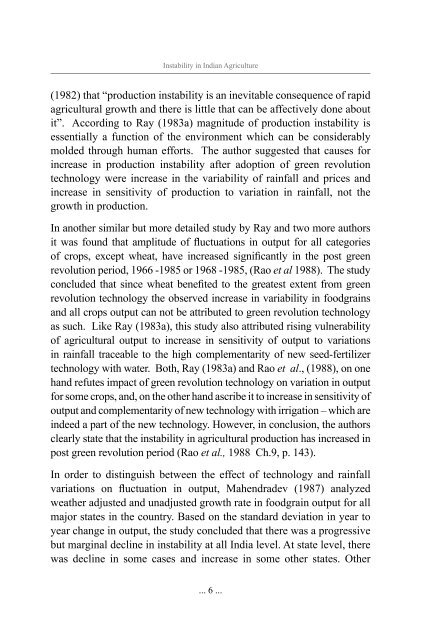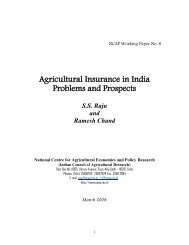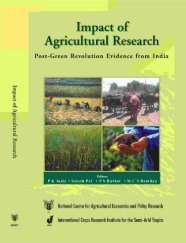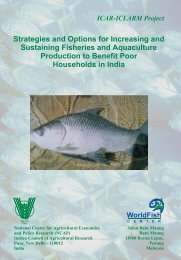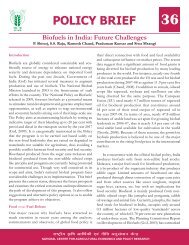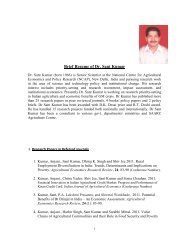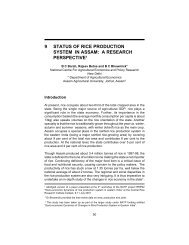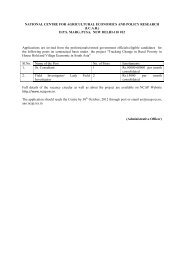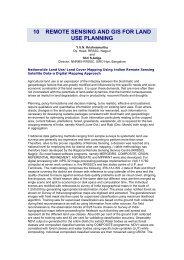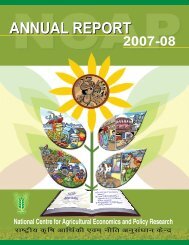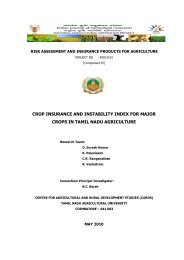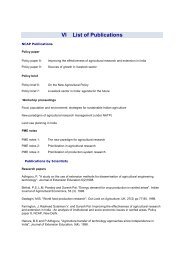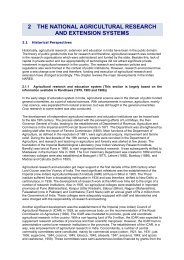Instability in Indian Agriculture - NCAP
Instability in Indian Agriculture - NCAP
Instability in Indian Agriculture - NCAP
You also want an ePaper? Increase the reach of your titles
YUMPU automatically turns print PDFs into web optimized ePapers that Google loves.
<strong>Instability</strong> <strong>in</strong> <strong>Indian</strong> <strong>Agriculture</strong><br />
(1982) that “production <strong>in</strong>stability is an <strong>in</strong>evitable consequence of rapid<br />
agricultural growth and there is little that can be affectively done about<br />
it”. Accord<strong>in</strong>g to Ray (1983a) magnitude of production <strong>in</strong>stability is<br />
essentially a function of the environment which can be considerably<br />
molded through human efforts. The author suggested that causes for<br />
<strong>in</strong>crease <strong>in</strong> production <strong>in</strong>stability after adoption of green revolution<br />
technology were <strong>in</strong>crease <strong>in</strong> the variability of ra<strong>in</strong>fall and prices and<br />
<strong>in</strong>crease <strong>in</strong> sensitivity of production to variation <strong>in</strong> ra<strong>in</strong>fall, not the<br />
growth <strong>in</strong> production.<br />
In another similar but more detailed study by Ray and two more authors<br />
it was found that amplitude of fluctuations <strong>in</strong> output for all categories<br />
of crops, except wheat, have <strong>in</strong>creased significantly <strong>in</strong> the post green<br />
revolution period, 1966 -1985 or 1968 -1985, (Rao et al 1988). The study<br />
concluded that s<strong>in</strong>ce wheat benefited to the greatest extent from green<br />
revolution technology the observed <strong>in</strong>crease <strong>in</strong> variability <strong>in</strong> foodgra<strong>in</strong>s<br />
and all crops output can not be attributed to green revolution technology<br />
as such. Like Ray (1983a), this study also attributed ris<strong>in</strong>g vulnerability<br />
of agricultural output to <strong>in</strong>crease <strong>in</strong> sensitivity of output to variations<br />
<strong>in</strong> ra<strong>in</strong>fall traceable to the high complementarity of new seed-fertilizer<br />
technology with water. Both, Ray (1983a) and Rao et al., (1988), on one<br />
hand refutes impact of green revolution technology on variation <strong>in</strong> output<br />
for some crops, and, on the other hand ascribe it to <strong>in</strong>crease <strong>in</strong> sensitivity of<br />
output and complementarity of new technology with irrigation – which are<br />
<strong>in</strong>deed a part of the new technology. However, <strong>in</strong> conclusion, the authors<br />
clearly state that the <strong>in</strong>stability <strong>in</strong> agricultural production has <strong>in</strong>creased <strong>in</strong><br />
post green revolution period (Rao et al., 1988 Ch.9, p. 143).<br />
In order to dist<strong>in</strong>guish between the effect of technology and ra<strong>in</strong>fall<br />
variations on fluctuation <strong>in</strong> output, Mahendradev (1987) analyzed<br />
weather adjusted and unadjusted growth rate <strong>in</strong> foodgra<strong>in</strong> output for all<br />
major states <strong>in</strong> the country. Based on the standard deviation <strong>in</strong> year to<br />
year change <strong>in</strong> output, the study concluded that there was a progressive<br />
but marg<strong>in</strong>al decl<strong>in</strong>e <strong>in</strong> <strong>in</strong>stability at all India level. At state level, there<br />
was decl<strong>in</strong>e <strong>in</strong> some cases and <strong>in</strong>crease <strong>in</strong> some other states. Other<br />
... 6 ...


